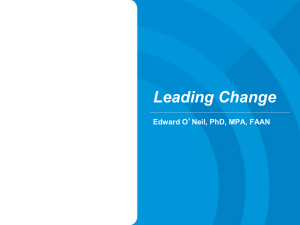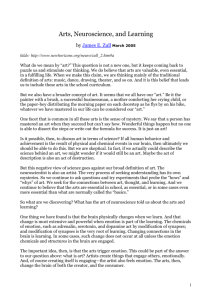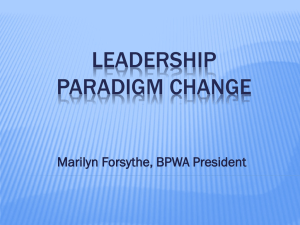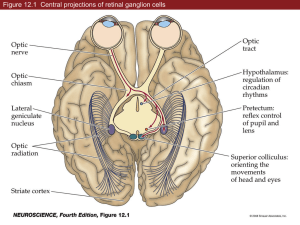NLN Summit 2010 handouts
advertisement
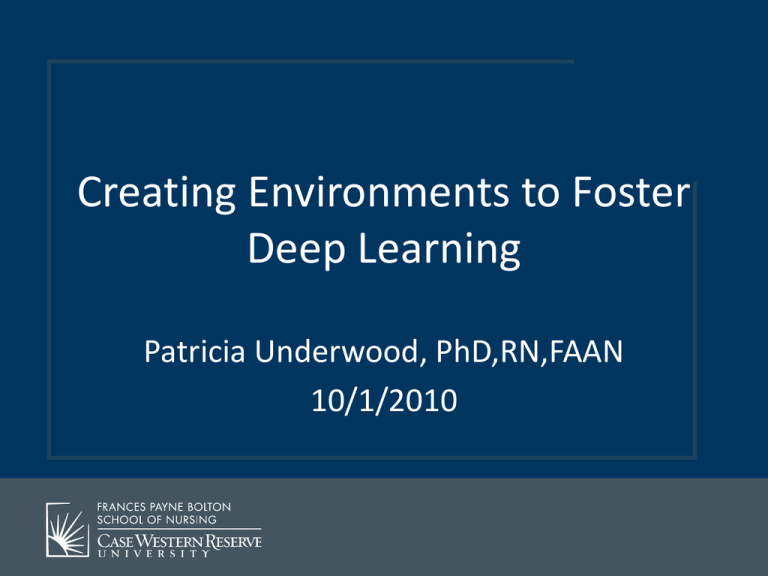
Creating Environments to Foster Deep Learning Patricia Underwood, PhD,RN,FAAN 10/1/2010 • Handouts may be found at: http://fpb.case.edu/Faculty/Underwood.shtm • Objectives: . – Describe Learning Paradigm & Constructivist approaches in fostering deep learning – Discuss implications of research on brain function & effective teaching for enhancing deep learning – Discuss potential strategies to foster deep learning Carnegie Report • Challenges us to transform nursing education . • To appreciate & prepare for the complexity of practice • To stop simply giving information about X but rather to coach students in developing the means to think about X enhancing connections between acquiring & using knowledge (p. 89) What is deep learning? Deep Learning: • Oriented to deriving . meaning (probing, exploring, considering new applications) • Translation to new situations, integration, synthesis, reflection Surface Learning: • Reproducing, rote memorization Achievement Learning: • Strategic • Doing just what is needed for a grade (often surface, some deep) How can we promote deep learning? . Through the orientation teachers bring to the learning situation: Use of a Learning vs a Teaching paradigm Barr & Tagg (1995) Teaching Paradigm . • Focus on means • Students passive recipients • Teacher is expert conveyer of knowledge • Strategies: lecture Learning Paradigm • Focus on outcomes • Students co-creators of knowledge • Teacher is coach & facilitator • Strategies: create meaningful experiences, active, reflection How can we promote deep learning? . • Use of theoretical approaches that foster development of new knowledge and integration: – Constructivism – Kolb’s Experiential Learning Theory Constructivism • Constructivist approach to learning is . consistent with the Learning Paradigm • Backwards planning: Outcomes first • Ask: How can I create an environment in which students can achieve the desired outcome? Question 1 . • What is one way in which the application of the Learning Paradigm and/or a Constructivist approach might promote learning for your students? Kolb’s Experiential Learning Theory How can we promote deep learning? Reflect on research on the brain & implications for education Zull’s articulation of brain function to Kolb’s Theory of Experiential Learning Knowledge of brain function: • Back & front cortex “talk to each other” . • Data are received and organized through reflection in the back cortex. Transformation only occurs when the data are converted to ideas, plans & actions in the front part of the cortex. • A balance in stimulating back & front cortex is encouraged Pressures according to Zull Emphasis on back cortex . • Information is valued • Students pressured to acquire data; teach to NCLEX • Teachers pressured to know the facts • Imbalance leads to feeling overwhelmed Emphasis on front cortex • Pressure to use new and active ways of teaching; engage students through play • Danger: making the classroom a playroom & trivializing learning Question 2 . • Give one example of how you might apply Zull’s research to your teaching? Research on the most effective teachers (Bain, 2004) What the best college teachers do • N = 63 qualitative narrative history design • Questions: – What learning objectives do you have? – How do you foster achievement? – What is your evidence of students’ successes? – What evidence do you have that your methods contribute significantly to students’ learning? The most effective teachers: • Approach teaching as an intellectual endeavor • Begin preparation with questions about student learning objectives • Expect more of their students • Emphasize objectives that embody the thinking & acting that is expected for life (consistent with Carnegie Report challenge) Teaching strategies: • Create natural critical learning . environments • Confront important problems • Challenge students to rethink assumptions & mental models of reality • Provide challenge with support Teaching strategies: • Provide learners with a sense of control . • Encourage collaboration • Provide fair, honest feedback as soon as possible and prior to any summative judgment Question 3 . • What one thing will you do based on Bain’s research that you are not currently doing? Effective teaching strategy • Planned considering desired learning . outcomes • Uses teacher as facilitator • Incorporates full ELT cycle • Promotes full brain activity • Maximizes neural development Carnegie Report encourages: • Scaffolding classes around patient & . population based care (use unfolding case studies, teaching narrative structures for making a case, simulation exercises & patient interviews in the classroom, & other strategies to allow for a dramatic rehearsal of patient care). Exercise Identify a focal group of students: 1. Identify one potential learning strategy to foster . deep learning among your students that you would like to try 2. Share with the person next to you & briefly (5 min.) discuss what might be the challenges of that strategy? Share examples with the larger group Resources: • Bain, K. (2004). What the best college teachers do. Cambridge, MA.: Harvard University Press. . • Barr, R.B. & Tagg, J. (1995). From teaching to learning. Change, • Benner, P., Sutphen, M., Leonard, V., & Day, L. (2009). Educating nurses: A call for radical transformation. • Felder, RM & Brent, R. (2005). Understanding student differences. Journal of Engineering Education, 94, 5772. Resources: • Zull, J. (2002 ). The art of changing the brain. . Sterling, VA: Stylus Publishing





